Pythium Root Rot Treatment – Identifying Pythium Rot In Barrel Cactus
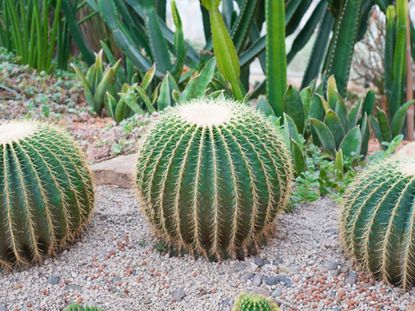

One of the trickier diseases of cacti is pythium rot. It most commonly affects barrel cacti and can be difficult to detect before it is too late to save the cactus. Pythium rot symptoms start at the soil level and generally begin in the roots. This makes it one of the hardest diseases of barrel cactus to diagnose, as most of the damage is underground. To add insult to injury, the soil is the host of the pathogen. If the soil is infected, the plant will certainly become ill. There are no effective methods of control of pythium rot, but some prevention can be undertaken.
What is Pythium Rot in Barrel Cactus?
Pythium is an internal soft rot that affects cacti and many other types of plants. In barrel cactus, it occurs when conditions are moist, when the plant is too deep in the soil, and when the cactus sustains an injury. For this reason, clean sterile soil and proper planting methods must be observed to prevent the pathogen from invading your cactus. Once the plant has the disease, there is no effective pythium root rot treatment. The cactus is best removed and destroyed. There are, however, preventative treatments for susceptible species. The disease stems from a soil-borne fungus-like organism. Once the roots are contaminated, the disease works its way up the cambium of the cactus and eventually will infect the entire plant. Once this happens, there is nothing to be done and the plant must be discarded. There are several common species of Pythium, each with favorite plant targets. While the disease is rarely found in commercial soil, it is easy to introduce through contaminated tools, old, dirty pots, and from animal activities. Even the use of dirty garden gloves can pass the pathogen into fresh, sterile soil.
Pythium Rot Symptoms
Pythium disease is almost impossible to detect until it is too late. This is because it starts in the soil at the plant's roots. If you were to remove the plant, you could see that roots are mushy, discolored, and rotten. Pythium rot in barrel cacti will also produce brown lesions on the roots. Once this occurs, the plant cannot uptake adequate nutrition and the whole core begins to die. The disease progresses upward, developing soft spots and decay as the whole stem turns yellow. If you watch the base of the plant for yellowing at the soil line, you might still be able to save it. Once the stem becomes squishy, however, the cactus is a lost cause. Pythium rot in barrel cacti is usually fatal.
Pythium Root Rot Treatment
Of all the diseases of barrel cactus, this is a particularly insidious variety. Since there are no adequate methods of control of pythium rot, the best defense is prevention. Avoid burying the plant in soil to the fleshy part of the stem. If the plant gets wounded at the soil line, keep water off the area and let it callus over. Preventative treatments can be applied by professionals to valuable specimens. These include mefanoxam and phosphytl-Al. Such treatments can be costly and are spotty in their effectiveness. Plants in containers should have only sterile soil and all tools need to be cleaned before using them with the cactus. With a little care and some luck, you can prevent a barrel cactus from ever getting infected and possibly losing this beautiful plant.
Gardening tips, videos, info and more delivered right to your inbox!
Sign up for the Gardening Know How newsletter today and receive a free download of our most popular eBook "How to Grow Delicious Tomatoes."

Bonnie Grant is a professional landscaper with a Certification in Urban Gardening. She has been gardening and writing for 15 years. A former professional chef, she has a passion for edible landscaping.
-
 How To Get Rid Of Mosquitoes In The Garden: 9 Natural Ways To Make Them Buzz Off!
How To Get Rid Of Mosquitoes In The Garden: 9 Natural Ways To Make Them Buzz Off!How to get rid of mosquitoes is on the minds of people in the summer in almost every region of the world. Learn how to repel the pests without toxic chemicals.
By Mary Ellen Ellis
-
 Monkey Orchid Care: How To Grow This Fascinating Species
Monkey Orchid Care: How To Grow This Fascinating SpeciesThe monkey orchid bears a remarkable resemblance to its namesake and, with a little know-how, can be successfully grown as a houseplant.
By Bonnie L. Grant
-
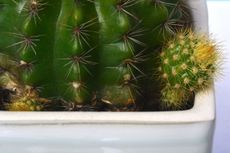 Barrel Cactus Propagation – How To Propagate Barrel Cacti From Pups
Barrel Cactus Propagation – How To Propagate Barrel Cacti From PupsIs your barrel cactus sprouting babies? Barrel cactus pups often develop on the mature plant. Many leave them and let them grow, creating a globular design in the container or in the ground. But you can propagate these for new plants too. Learn how in this article.
By Becca Badgett
-
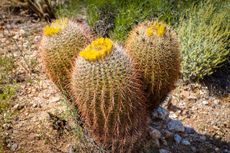 Compass Barrel Cactus Facts – Information About California Barrel Cactus Plants
Compass Barrel Cactus Facts – Information About California Barrel Cactus PlantsThere are a few different plants that go by the name “barrel cactus,” but Ferocactus cylindraceus, or California barrel cactus, is a particularly beautiful species with long spines. Learn more California barrel cactus information in this article.
By Liz Baessler
-
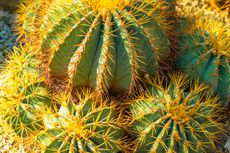 Blue Barrel Cactus Care – Growing Blue Barrel Cactus Plants
Blue Barrel Cactus Care – Growing Blue Barrel Cactus PlantsThe blue barrel cactus is an attractive plant with its perfectly-round shape, bluish color, and pretty, spring flowers. If you live in a desert climate, grow this outdoors. If you are in a colder climate, blue barrel cactus care in an indoor container is simple. Lean more here.
By Mary Ellen Ellis
-
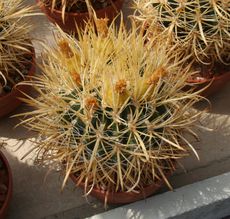 Ferocactus Chrysacanthus Info: How To Grow Ferocactus Chrysacanthus Cacti
Ferocactus Chrysacanthus Info: How To Grow Ferocactus Chrysacanthus CactiEven if you don’t live in the desert, cactus can be grown indoors as well in most any climate. Interested in learning how to grow Ferocactus chrysacanthus? The following article on Ferocactus chrysacanthus info discusses growing and care of this cactus.
By Amy Grant
-
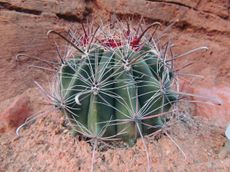 Barrel Cactus Care – Learn How To Grow An Arizona Barrel Cactus
Barrel Cactus Care – Learn How To Grow An Arizona Barrel CactusArizona barrel cactus is commonly known as fish hook barrel cactus, an appropriate moniker due to the formidable hook-like spines that cover the cactus. This impressive cactus is suitable for growing in USDA zones 9-12. Learn how to grow an Arizona barrel cactus here.
By Mary H. Dyer
-
 Golden Barrel Care Guide – Learn About Golden Barrel Cacti
Golden Barrel Care Guide – Learn About Golden Barrel CactiThe golden barrel cactus plant is an attractive and cheerful specimen, rounded and growing to as much as three feet tall and three feet around much like a barrel, hence the name. Be careful, though, as it has long dangerous spines. Learn about growing this cactus here.
By Becca Badgett
-
 Emory Cactus Care – How To Grow An Emory’s Barrel Cactus
Emory Cactus Care – How To Grow An Emory’s Barrel CactusFerocactus emoryi are robust cacti perfect for drought-prone gardens and dry landscapes. Commonly referred to as Emory’s barrel cactus, these cylindrical spiny plants are an interesting choice for containers and addition to desert rock gardens. Learn more here.
By Tonya Barnett
-
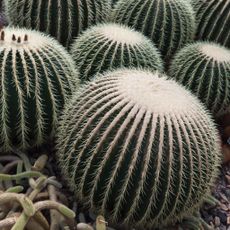 Ferocactus Plant Info – Growing Different Types Of Barrel Cacti
Ferocactus Plant Info – Growing Different Types Of Barrel CactiA wide range of barrel cactus varieties are found in the gravelly slopes and canyons of the Southwestern United States and much of Mexico. Click this article to learn about a few of the most popular barrel cactus varieties.
By Mary H. Dyer